Smart Door Locks Market Research - 2032
The Global Smart Door Locks Market size was valued at $1.8 billion in 2020, and is projected to reach $12.5 billion by 2032, growing at a CAGR of 17.6% from 2023 to 2032. A smart door lock is an electronic lock system that provides keyless entry and additional features such as convenience, security, and remote access control. Unlike traditional locks that require a physical key, a smart door lock uses various authentication methods to grant access, such as PIN codes, keycards, fingerprint recognition, or smartphone connectivity.
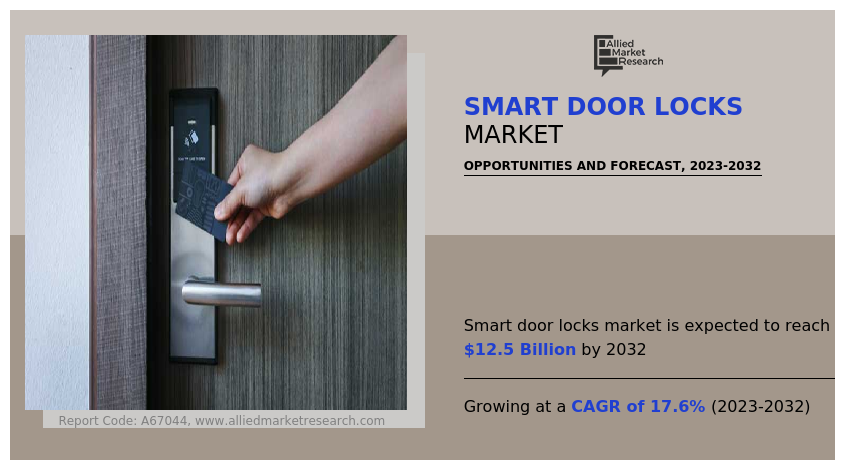
Smart Door Locks Market Dynamics
An increase in demand for smart door locks is expected to boost the growth of the market. Smart door locks are not a new concept in building security systems and are widely used in businesses, homes, and hotels. However, the popularity of smart locks in residential units is recent, in part due to the prevalence of connectivity that allows remote control of locks using smartphones. The basic motor function of smart locks is to control the position of a deadbolt or latch. Most systems use brushed DC motors for this application because it requires fewer components and is simpler in design. Customers are interested in adopting smart door locks in commercial and residential spaces, owing to features such as flexibility with high security, ease of installation, remote locking and unlocking, and the provision of sending quick alerts to homeowners in the event of a burglary. smart door locks with technological integration provide great safety and reliability, which boosts the growth of the smart door locks market.
In addition, key players use facial recognition technology in their products, as well as automatic motion detection, which serves as an additional driver for the smart door locks market. Furthermore, vendors are engaged to offer smart locks, which are highly compatible with specific features, thus boosting the growth of the smart door locks market.
The increase in the use of smartphones across the globe has fueled the adoption of smart door locks. Smart door locks mobile applications give real-time notifications. These allow the customer to access their locks through the smartphone app and grant access to anyone if required. Thus, an increase in the trend of using app-based locks across various commercial and residential sectors is expected to drive the smart door locks market.
In addition, Smart door locks are often designed to be controlled and managed through mobile applications. These apps enable users to lock or unlock their doors remotely, monitor door activity, and manage access permissions. The widespread use of smartphones means that users have a convenient and familiar interface to interact with their smart door locks.
In addition, smart door locks offer convenience by eliminating the need for physical keys and providing keyless entry methods such as PIN codes, fingerprint recognition, or smartphone access. It also enhances security by providing features like activity monitoring, temporary access codes, and remote locking and unlocking. The desire for convenience and improved security is a significant driver for the adoption of smart door locks. Moreover, the growth of the smart home ecosystem has been a major driver for smart door locks.
As more homeowners adopt smart home devices and systems, the integration of smart door locks becomes a natural extension. Integration with voice assistants, home automation platforms, and other smart devices allows users to create seamless and interconnected smart home experiences and is expected to boost the growth of the smart door locks market.
Rising awareness of home automation technologies, including smart door locks is increasing the adoption of smart door locks. In addition, the availability of wireless technologies like Wi-Fi and Bluetooth allows homeowners to remotely control and monitor their locks, providing a seamless user experience. Moreover, technological advancements have played a significant role in the growth of the smart door locks industry. However, the high initial investments and high-security threats are anticipated to restrain the smart door lock market growth during the forecast period.
The smart door locks market overview is witnessing various obstructions in its regular operations due to the COVID-19 pandemic and inflation. Earlier, the worldwide lockdowns resulted in reduced industrial activities, eventually leading to reduced demand for smart door locks from various sectors such as construction and industrial. However, COVID-19 has subsided, and the major manufacturers in 2023 are performing well. Contrarily, the rising global inflation is a new major obstructing factor for the entire industry.
The inflation, which is a direct result of the Ukraine-Russia war, and few long-term impacts of the coronavirus pandemic, has introduced volatility in the prices of raw materials used for manufacturing smart door locks. However, India and China are performing relatively well. In addition, inflation is expected to worsen in the coming years, as the possibility of the ending of the war between Ukraine and Russia is less. Moreover, the cost of construction has risen substantially, discouraging builders from initiating new projects, which is also expected to negatively affect the smart door locks market growth. However, with the continued talks between different countries, a peace agreement between Ukraine and Russia can be devised.
Smart Door Locks Market Segmental Overview
The smart door locks market is segmented into Product Type, Technology, and End-User, and Region. By-products, it is divided into deadbolts, lever handles, padlocks, and others. By technology, the Smart door locks market is classified into Wi-Fi and Bluetooth. By end-user, it is divided into single-family and multi-family. By region, it is analyzed across North America, Europe, Asia-Pacific, and LAMEA.
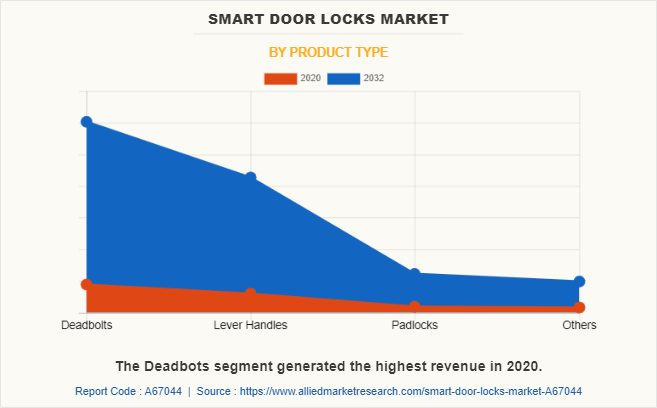
By Product Type:
The smart door locks market is categorized into deadbolts, lever handles, padlocks, and others. Deadbolts smart locks are advanced locking systems that combine traditional deadbolt mechanisms with smart technology. The deadbolts are expected to dominate the smart door locks market during the forecast period. The lever handles segment is expected to grow at the highest CAGR during the forecast period. Deadbolt smart locks are one of the most popular types of smart locks. It is designed to replace traditional deadbolt locks and provide keyless entry options.
Deadbolt smart locks typically offer features such as PIN code entry, remote access control, and integration with smart home systems. It also eliminates the need for traditional keys by allowing users to unlock their doors using various methods such as PIN codes, biometric identification (fingerprint or facial recognition), or proximity sensors.
In addition, one of the significant advantages of smart door locks is the ability to control and monitor access to the home remotely. It is also compatible with popular smart home platforms like Amazon Alexa, Google Assistant, or Apple HomeKit. This integration enables us to incorporate the lock into a broader smart home ecosystem, allowing for automation and voice control. It also has the feature of tracking access and identifying suspicious activity and offers real-time notifications and alerts to the smartphone whenever the door is locked or unlocked.
Moreover, the Deadbolts smart door locks come in various models and brands such as Yela and August Home with various features and easy installation. The evolution of IoT, increase in penetration of 4G and 5G networks, growing trend of smart homes, and rise in applications in building security & house security are anticipated to increase the development of smart deadbolt locks. All such features are expected to drive the demand for smart door locks during the forecast period.
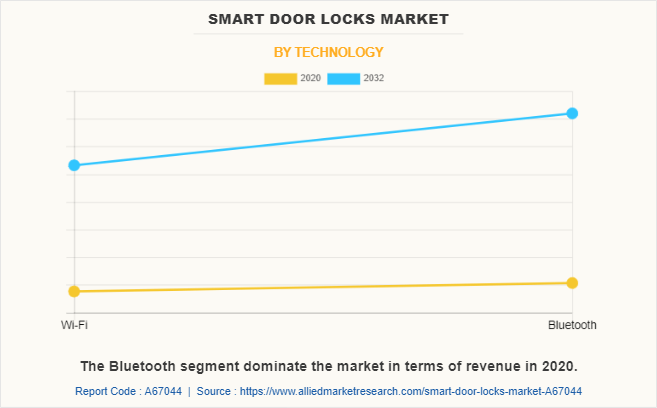
By Technology:
The Smart door locks market is divided into Wi-Fi and Bluetooth. The Wi-Fi segment is expected to grow at the highest CAGR during the forecast period. The increasing popularity of smart home technologies and the growing market for connected devices have also contributed to the adoption of Wi-Fi smart door locks. In addition, smart door locks integrate with other smart home devices and platforms. This integration allows for the creation of automated routines or interactions between various smart devices.
For example, a smart lock can be integrated with a home security system, so the door automatically locks when the security system is armed. This integration enhances the overall functionality and efficiency of a smart home ecosystem. Moreover, it has various advantages such as convenience, guest access management, integration with virtual voice assistants, and others. It also provides advanced security features that provide an additional layer of protection. It also offers features such as encryption, tamper detection, alarm systems, and activity logs.
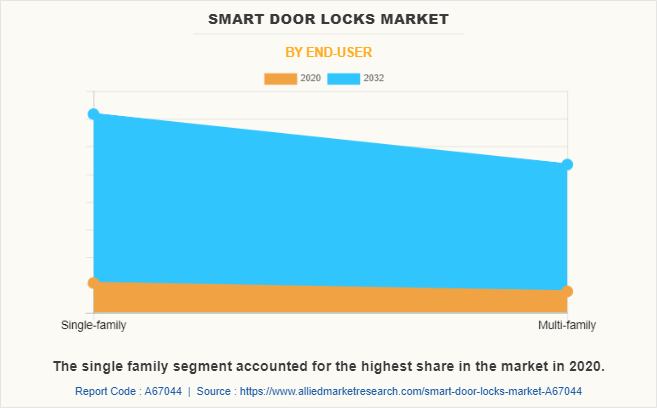
By End-User:
The Smart door locks market is categorized into single-family and multi-family. The single-family segment dominated the smart door lock market and multi-family is expected to grow at the highest CAGR during the forecast period. A rapid rise in residential buildings can be witnessed globally, which is attributed to the rapid rise in urbanization. Moreover, the rise in the global population has also positively affected residential building construction. In addition, smart door locks can integrate with existing security systems, including CCTV cameras, alarm systems, and access control systems.
The integration allows for a more comprehensive and centralized security solution, enabling businesses to monitor and manage all aspects of their security infrastructure from a single platform. Moreover, the increasing adoption of smart door locks in multi-family homes provides businesses with advanced access control management, audit trails, integration capabilities, remote management, and scalability. These features enhance security, streamline operations, and improve overall efficiency in residential environments. Such factors are positively influencing the smart door locks market for the multi-family segment.
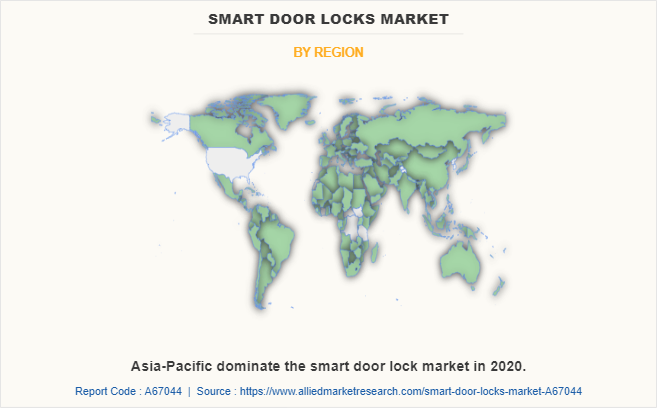
By Region:
The smart door locks market is analyzed across North America, Europe, Asia-Pacific, and LAMEA. In 2021, Asia-Pacific had the highest smart door locks market share and is anticipated to secure the leading position during the forecast period, due to the growing adoption of advanced security and authentication solutions in various end-user verticals, such as single-family and multi-family. The major driving factors of the smart door locks market include improvement in economic conditions, change in lifestyle, and growth in awareness about smart security systems and smart door locks products.
In addition, increasing urbanization is witnessing with a rising number of people in urban areas is expected to boost the smart door locks market growth. Urban dwellers often prioritize convenience and security, making smart door locks an attractive solution for their homes. The urban population's demand for smart home technologies, including smart door locks, is driving market growth in the region. Moreover, an increase in disposable income and improving living standards is also expected to fuel the smart door locks market.
Rise in construction activities and government initiatives and smart city developments are fueling the smart door locks market opportunity. In addition, several countries such as China, India, and Japan in the Asia-Pacific region are actively investing in smart city development and promoting the adoption of smart technologies. These initiatives often include incentives and policies that encourage the use of smart home technologies, including smart door locks. Government support and initiatives are propelling market growth in the region. These factors are anticipated to drive the adoption of the smart door locks market in the region.
Competition Analysis
Competitive analysis and profiles of the major players in the smart door locks markets, such as Assa Abloy Group, Honeywell International Inc., Haven Lock Inc., Panasonic Corporation, Samsung Group, Salto Systems, Schlage, Spectrum Brands Holdings Inc., Vivint Smart Home Inc., and Xiaomi Corporation are provided in this report. There are some important players in the smart door lockmarket such as Assa Abloy Group, Schlage, and Vivint Smart Home Inc. Major players have adopted product launch and acquisition as key developmental strategies to improve the product portfolio of the smart doors locks market.
Some examples of product launches in the market
In November 2021, Salto introduced the XS4 Original+, the next-generation, flexible, and reliable smart locking solution with various features, a beautiful design with a sleek flat reader in two new colors. This aims to improve the product portfolio.
In September 2022, Assa Abloy launched a new product under the Yale brand, namely Yale Assure Lock 2, which is the smartest residential lock for security purposes. This aims to improve the product portfolio.
In October 2022, Kwikset launched two new products such as SmartCode 260 Keypad Deadbolts and SmartCode 270 Touchpad Deadbolts. Both deadbolts are available in Traditional (TRL) and Contemporary (CNT) styles and feature BILT® app support. It provides a seamless way for homeowners to experience the benefits of keyless entry. This launch aims in improving the product portfolio.
In January 2023, Schlage, a leading provider of home security and access solutions for over a century, launched the Schlage EncodeTM Smart WiFi Lever at the 2023 NAHB International Builders' Show (IBS). With expanding the award-winning Schlage Encode family, the latest smart lock is designed to work on standard single bore-hole doors, offering the security and convenience of the smart lock experience to more areas of the home.
In February 2023, Xiaomi launched its latest addition to the smart home product line with the Xiaomi Smart Door Lock M20 series. This new model, named the “Smart Guardian Can See” is equipped with an integrated peephole camera and a display screen, providing users with a comprehensive view of the front door in real time. This aims to improve the product portfolio.
Key Benefits For Stakeholders
- The report provides an extensive analysis of the current and emerging smart door locks market trends and dynamics.
- An in-depth smart door locks market analysis is conducted by constructing market estimations for key market segments between 2022 and 2032.
- An extensive analysis of the smart door locks market outlook is conducted by following key product positioning and monitoring of top competitors within the market framework.
- A comprehensive analysis of all the regions is provided to determine the prevailing opportunities.
- The smart door locks market forecast analysis from 2023 to 2032 is included in the report.
- The key players within the smart door locks market are profiled in this report and their strategies are analyzed thoroughly, which helps understand the competitive outlook of the smart door locks industry.
Smart Door Locks Market Report Highlights
| Aspects | Details |
| Market Size By 2032 | USD 12.5 billion |
| Growth Rate | CAGR of 17.6% |
| Forecast period | 2020 - 2032 |
| Report Pages | 242 |
| By Product Type |
|
| By Technology |
|
| By End-User |
|
| By Region |
|
| Key Market Players | Schlage, Assa Abloy, Samsung Group, Xiaomi Corporation, Panasonic Corporation, Spectrum Brands Holdings, Inc, Haven Lock, Inc., Vivint Smart Home, Inc., Honeywell International Inc., SALTO Systems |
Analyst Review
The smart door locks market has observed huge growth in North America, Asia-Pacific, and Europe. Asia-Pacific is projected to register significant demand in the near future due to a rise in urbanization and a surge in investment in infrastructure by government authorities. Moreover, the increase in robbery cases and threats to the safety of individuals and households is further anticipated to propel the growth of the smart door locks market. In addition, customers are focused on adopting smart homes owing to features, such as easy installation, high security, remote locking & unlocking, and quick alerts to homeowners in the event of a burglary, which favors the growth of the smart door locks market. Furthermore, rapid development in smart cities all over the globe is likely to expand the smart door locks market.
Various market players have adopted strategies, such as product launches, business expansion, acquisition, and agreements to expand their business and strengthen their market position. For instance, in October 2022, Kwikset launched two new products as Smart Code 260 Keypad Deadbolts and Smart Code 270 Touchpad Deadbolts. Both deadbolts are available in Traditional (TRL) and Contemporary (CNT) styles and feature BILT app support. It provides a seamless way for homeowners to experience the benefits of keyless entry. This launch aims to improve the product portfolio. As a result, such strategic moves are expected to provide lucrative growth opportunities in the global smart door locks market.
The global smart door locks market was valued at $1.8 billion in 2020 and is projected to reach $12.5 billion by 2032, growing at a CAGR of 17.6% from 2023 to 2032.
The smart door locks market encompasses electronic locking systems that provide keyless entry and features like remote access control, utilizing authentication methods such as PIN codes, keycards, fingerprint recognition, or smartphone connectivity.
Key players in the smart door locks market include companies integrating advanced technologies like facial recognition and automatic motion detection into their products, enhancing security and user convenience.
Factors driving the market include increased demand for keyless entry systems, technological integration offering enhanced safety and reliability, and the widespread use of smartphones enabling remote control of locks.
The increase in the use of smartphones across the globe has fueled the adoption of smart door locks.
Assa Abloy Group, Honeywell International Inc., Haven Lock Inc., Panasonic Corporation, Samsung Group, Salto Systems, Schlage, Spectrum Brands Holdings Inc., Vivint Smart Home Inc., and Xiaomi Corporation are the top companies to hold the market share in Smart Door Locks.
Loading Table Of Content...
Loading Research Methodology...



